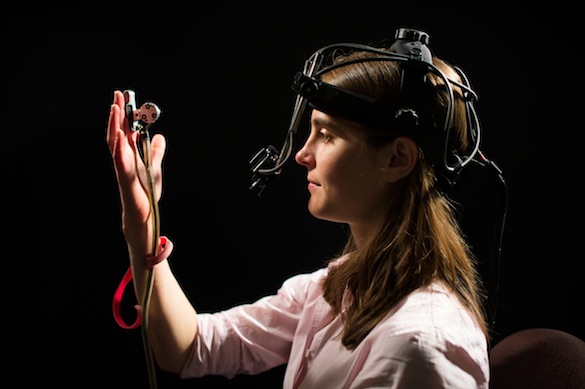As previously mentioned, mirror-box
therapy has proven effective in alleviating phantom limb sensations. This
therapy was based on the idea that vision can dictate proprioception (2). By
allowing patients to perceive two intact limbs (the mirror allows a projection
of the intact limb onto the amputated limb), patients are able to correct their
perceived sensation. To reinforce this
relationship between vision and proprioception, researchers recently examined
whether visual responses associated with self-generated movements could be
evoked in the complete absence of light (1).
Generally the visual pathway is as
follows: photons hit the retina of the eyes, striking the rods and cones, synapses
with bipolar, horizontal, ganglion, and amacrine cells; the action potential
propagates through the optic nerve, through the thalamus, and to the primary
visual cortex where the stimulus is interpreted. It is also important to mention that when our
eyes are not tracking anything in particular they engage in jerky movements,
called saccades. In contrast, while tracking a particular object in our visual
field our eyes make smooth movements, referred to as smooth pursuit. Smooth
pursuit is only possible while tracking something tangible – mental imagery doesn’t
elicit this response! (1) Based on this information,
in the complete absence of light - the stimulus, we should not be able to
generate visual responses nor be able to make smooth pursuit movements. However, our brains are amazing! Recent
research has shown that many people are able to have retinal responses to a
moving target in the absence of light.
So you might also be wondering how
researchers would test this. Initially, all participants gave self-reports
about whether they could see their arm, or a researcher’s arm, moving in front
of their eyes with a light-proof blindfold on. To confirm the presence of smooth pursuit in
total darkness, researchers then strapped one of these bad boys on the
participants’ heads.
As before, participants were asked to move their arm in
front of their eyes. Researchers also
waved their arms in front of the participants’ eyes. In a large percentage of participants, smooth
pursuit movements, consistent with object tracking in adequate light, were
recorded (1). This effect was amplified in participants with varying types of synesthesia
(1). Although the mechanism is not entirely clear, this reinforces the idea
that the brain is able to use body movement to stimulate a visual response in
the complete absence of visual input.
References:
1. Dieter
KC, Hu B, Knill DC, Blake R, Tadin D. Kinesthesis can make an invisible hand
Visible. Psychological
Science. Oct. 2013. 10: 1-10.
2. Ramachandran, V. S., & Rogers-Ramachandran, D. Synaesthesia
in phantom limbs induced with mirrors. Proceedings
of the Royal Society B: Biological Sciences. 1996. 263: 377–386.

No comments:
Post a Comment